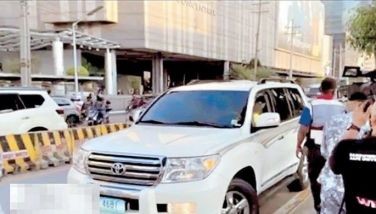Pattern ‘istambay’ drive after ‘Broken Windows’

If refocused the drive against “istambays” can work for the common good.
It should be renamed, for starters. Cops cannot arrest a citizen just for loitering (“istambay” is pidgin for “bystander”). Congress repealed in 2012 the anti-vagrancy proviso of the Revised Penal Code. Before that it literally was a catchall for all sorts of real and imagined night offenses, like graffiti painting, sleeping, and necking in parks. At dawn busloads of scruffy “bagansiya” arrestees were delivered from police stations to inquest fiscals for scolding prior to release.
The new name must show legality. To their credit the National Police brass did not blindly pick up and throw “istambays” into the river. Civil libertarians had warned there has to be legal basis for any arrest. The 5,000 nabbed in Metro Manila last weekend were for breach of local ordinances: drinking, smoking, gambling, urinating, spitting, littering, nakedness in the street; curfew on minors; even loud videoke-ing in the wee hours. Makati cops who wrongfully jailed six party-going officemates waiting outside a friend’s house were punished.
Accosting ordinance breakers would result in two pluses. One, peace and order in neighborhoods. Two, the capture of worse criminals, like robbers and murderers. The drive must integrate local governments and police with citizens, in so-called “Broken Windows Policing.” That method was tried out in blighted, crime-prone New York City in the 1990s. Cops did not just stop and frisk petty offenders, knowing that zealotry begets resistance. They worked on improving communities. It was so successful that Mayor Rudy Giuliani was re-elected, police commissioner William Bratton became in demand, and Broken Windows policing was replicated worldwide.
I wrote about Broken Windows law enforcement in Feb. 2004. Apt even 14 years after, let me rerun it below.
* * *
Davao is one of Asia’s 20 most livable cities. Nobody dares smoke in public halls, lest the police clap them in jail. Puerto Princesa has the finest fish in market. Vendors dutifully have their catch tested for traces of cyanide or dynamite, fearful of losing their license for selling even one poisoned or blasted fry. Pagudpud at the tip of Ilocos Norte is the country’s cleanest town, where stiff fines await litterbugs. Motorists become careful upon entering Subic Freeport, where road rules strictly are enforced. Marikina has no sidewalk vendors or boorish jeepney drivers choking up traffic.
The five are the envy of others. Their mayors, police, and residents join hands to make their locales relatively free of violent crime. Starting with the basics of courtesy, cleanliness, and consciousness of others’ needs, they better their own lives. They somehow have this “Broken Windows” concept of keeping serious crimes at bay.
Broken Windows is the brainchild of American criminologists James Q. Wilson and George Kelling. “Crime is the inevitable result of disorder,” they theorized. If a broken window is left unrepaired, people walking by will conclude that no one cares and no one is in charge. Soon more windows will be broken, and a sense of anarchy will spill out from the building to the street it faces, sending the message that anything goes. In a big city relatively minor problems – graffiti, street hawking, littering, panhandling, uncouth driving are, following Wilson and Kelling’s observation, like broken windows – invitations to more serious infractions of the law.
“Muggers and robbers, whether opportunistic or professional, believe they reduce their chances of being caught or identified if they operate on streets where potential victims are intimidated by prevailing conditions,” the duo wrote. “If a neighborhood cannot keep a panhandler from annoying passersby, the thief may reason, it is even less likely to call the police about a potential mugger or to interfere if the mugging actually takes place.”
New York City was a crime haven. Officials fought back with Broken Windows, hiring Kelling as consultant of the Transit Authority. With the subway director, he cleaned up all train cars of graffiti. Each night, all coaches spray-painted by street gangs were removed from service and scrubbed. The gangs eventually gave up. Not one of their masterpieces saw the light of day anyway.
Kelling moved on to next stage with the hiring of Bratton as new transit police chief who also believed in Broken Windows. They took on the fare-beaters who jumped turnstiles instead of paying the basic $1.25. The Transit Authority used to not bother with the problem because of the small amount compared to the huge solution cost. But Kelling and Bratton worried that decent people could turn into fare-beaters as well if nothing was done. The habitual fare-beaters they apprehended turned out to be carrying deadly weapons or wanted for serious crimes. Breathing down their necks everyday, the police also wiped out subway muggers.
Bratton soon became city police chief under Mayor Giuliani in 1994. Employing Broken Windows, they took on the aggressive panhandlers and “squeegee men” who swarmed on motorists at stoplights and menacingly demanded payment for washing car windshields. For them minor, seemingly insignificant quality-of-life crimes were tipping points for violent ones. Drug peddlers and muggers soon steered clear of streets that NYPD cleaned of the smallest offenders.
* * *
Catch Sapol radio show, Saturdays, 8-10 a.m., DWIZ (882-AM).
Gotcha archives on Facebook: https://www.facebook.com/pages/Jarius-Bondoc/1376602159218459, or The STAR website https://www.philstar.com/columns/134276/gotcha
- Latest
- Trending

























